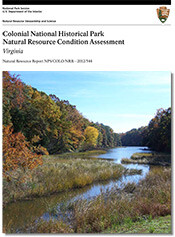Workshop in Colonial National Historical Park kicks off natural resource assessment
 Bill Dennison, Tim Carruthers, Jane Thomas, and Kate Bentsen traveled to Colonial National Historical Park on March 10-11 to initiate a Natural Resources Condition Assessment process that will continue over the next 18-24 months. The visit included a meeting with park personnel at the Yorktown Battlefield Visitors Center, followed by a tour of the entire park on the first day. On the second day, we held a mini-symposium at the Virginia Commonwealth University’s Rice Center on the James River. Colonial National Historical Park consists of Yorktown Battlefield on the York River, Jamestown on the James River, and Colonial Parkway, which connects Yorktown and Jamestown via historic Williamsburg. See IAN blog post for more details.
Bill Dennison, Tim Carruthers, Jane Thomas, and Kate Bentsen traveled to Colonial National Historical Park on March 10-11 to initiate a Natural Resources Condition Assessment process that will continue over the next 18-24 months. The visit included a meeting with park personnel at the Yorktown Battlefield Visitors Center, followed by a tour of the entire park on the first day. On the second day, we held a mini-symposium at the Virginia Commonwealth University’s Rice Center on the James River. Colonial National Historical Park consists of Yorktown Battlefield on the York River, Jamestown on the James River, and Colonial Parkway, which connects Yorktown and Jamestown via historic Williamsburg. See IAN blog post for more details.
UMCES researchers attend biennial Coastal and Estuarine Research Federation Conference
 IAN and UMCES researchers attended the biennial Coastal and Estuarine Research Federation's conference in Daytona Beach, Florida in early November 2011. This international conference brings together all the diverse disciplines within coastal and estuarine science, such as geochemistry, physical oceanography, biological systems, management, and education. Several IAN researchers presented on their integrated assessments of Baltimore Harbor, National Park Service parks, and the Great Barrier Reef, as well as attended plenary and poster sessions.
IAN and UMCES researchers attended the biennial Coastal and Estuarine Research Federation's conference in Daytona Beach, Florida in early November 2011. This international conference brings together all the diverse disciplines within coastal and estuarine science, such as geochemistry, physical oceanography, biological systems, management, and education. Several IAN researchers presented on their integrated assessments of Baltimore Harbor, National Park Service parks, and the Great Barrier Reef, as well as attended plenary and poster sessions.
Colonial National Historical Park Natural Resource Condition Assessment
 Colonial National Historical Park offers a vast array of cultural resources, notably the site of the first English settlement at Jamestown in 1607 and the Siege of Yorktown in 1781 that proved to be the last major campaign of the American Revolution. Four dominant habitat groupings are present within the Park, including forest, grassland, non-tidal wetland, and tidal wetland. Threats to Colonial NHP have been categorized into: internal (within the park), watershed (outside and around park boundaries), and regional (threats that impact the entire region). The combined natural resources of Colonial NHP were assessed as on the border between "degraded" and "fair", attaining 40% of desired threshold scores.
Colonial National Historical Park offers a vast array of cultural resources, notably the site of the first English settlement at Jamestown in 1607 and the Siege of Yorktown in 1781 that proved to be the last major campaign of the American Revolution. Four dominant habitat groupings are present within the Park, including forest, grassland, non-tidal wetland, and tidal wetland. Threats to Colonial NHP have been categorized into: internal (within the park), watershed (outside and around park boundaries), and regional (threats that impact the entire region). The combined natural resources of Colonial NHP were assessed as on the border between "degraded" and "fair", attaining 40% of desired threshold scores.

